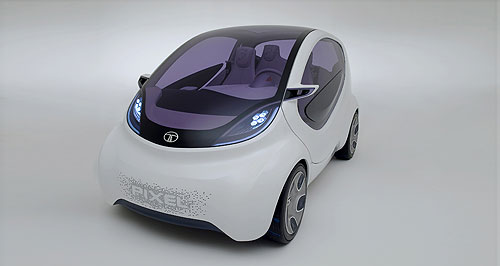Future models - TataLong wait for passenger cars, says TataOut with the old way: Tata will focus on more 'global' passenger cars in future years, rather than Indian-specific models such as the Nano. A shift to globally competitive products will stall Tata’s Australian roll-out28 Oct 2013 By BARRY PARK TATA will wait up to five years before introducing its first passenger car to Australia, but according to the Indian car-making giant, it should be worth the wait. The company plans on rolling out three completely new products a year for the next five years as it changes from a focus on building vehicles for emerging markets to one that can compete on a global scale. However, passenger cars will take a back seat as the company focuses on the roll-out of commercial vehicles – the area in which Tata has its foundations as a vehicle manufacturer. “We made cars for the Indian market to start with, and it is really only in the last 10 years that we've been making vehicles for the global market, and looking after them in the global markets, and then coming back and making it not just for the Indian market,” Tata’s head of international business for its commercial vehicle business unit, R.T. Wasan, said. “But (Tata is now in) a phase where we are now going to start working on the development of vehicles that will be competing with global cars,” he said. “It will take a bit of time to come to market, but as we stand today, there's a product that is being developed with a global market in mind.” In terms of passenger cars, Mr Wasan said, the first arrival could be up to five years away as Tata reshaped its passenger vehicle range to become a global, rather than India-centric, brand. The brand’s official Australian distributor, Fusion Automotive, has flagged that it is keen to start bringing in more Tata-badged models as the globally competitive versions of them roll out, but will have to wait for the passenger range. The most likely candidate, according to both Mr Wasan and Darren Bowler, the managing director of Fusion, is a small Corolla-sized car that will have to be carefully assessed before it is launched in Australia. “Look, a small car would be ideal,” Mr Bowler said. “But that is an incredibly competitive segment and if you were coming into that segment you would need to have the product that is 100 percent correct for the Australian market. “Our planning will be aligned with those attributes, at the right point in time when we do that.” Mr Bowler said Fusion’s focus for now was on launching light commercial vehicles, and the Tata brand. “Certainly over the next few years we're talking about heavy trucks we're talking about medium trucks, and we're talking about buses, and at some time passenger cars will be on the radar as well,” he said. One car that has definitely been ruled out for Australia is the Nano city hatchback, developed as an affordable alternative to a motorcycle for middle-class Indian families. “Nano is a fantastic car, but Nano was designed and built for India as the people's car,” Mr Bowler said. “For us that car would be won't be coming to Australia as part of our planning. At this point of time it is not ideal for Australia, but in the future, who knows what might happen? “Maybe we can cater for those people's demands in, I don't know, however many years?” he said. Passenger cars aside, the first new entrant is likely to be a new generation of the Daewoo-sourced Prima heavy truck, sold off to Tata at the same time as Australian car-maker Holden took a controlling stake in the bankrupt Daewoo car-making division. According to Tata sources, it will be very different to the traditional heavy truck on sale already in Australia when it arrives next year – and will boast up to 2000 Newton metres of torque. The Tata Xenon, launched in 2007, is also destined for an update, with one Tata source saying the body-on-frame design of the Land Rover Discovery was a potential candidate for the next generation of the trade ute. One aspect of Tata’s future product that potentially won’t make it into the passenger car range is hand-me-down technology from Tata’s luxury brand, Jaguar Land Rover. According to Tata executive director of commercial vehicles Ravi Pisharody, while the JLR and Tata teams do work together, bringing premium technology into value-driven cars would work against the brand. “The fact is today the products are very different,” Mr Pisharody said. “JLR is really catering to only premium audience and premium market, whereas Tata is trying to distance itself by the fact that we cater to the mass market. “But having said that, we look at a new generation of pick-ups and Novus (heavy truck) which are still not, I would say, put on paper in terms of what they will be like, we will see if there are some learnings and technology from JLR which we can incorporate,” he said.  Read more |
Click to shareTata modelsMotor industry news |
















Facebook Twitter Instagram